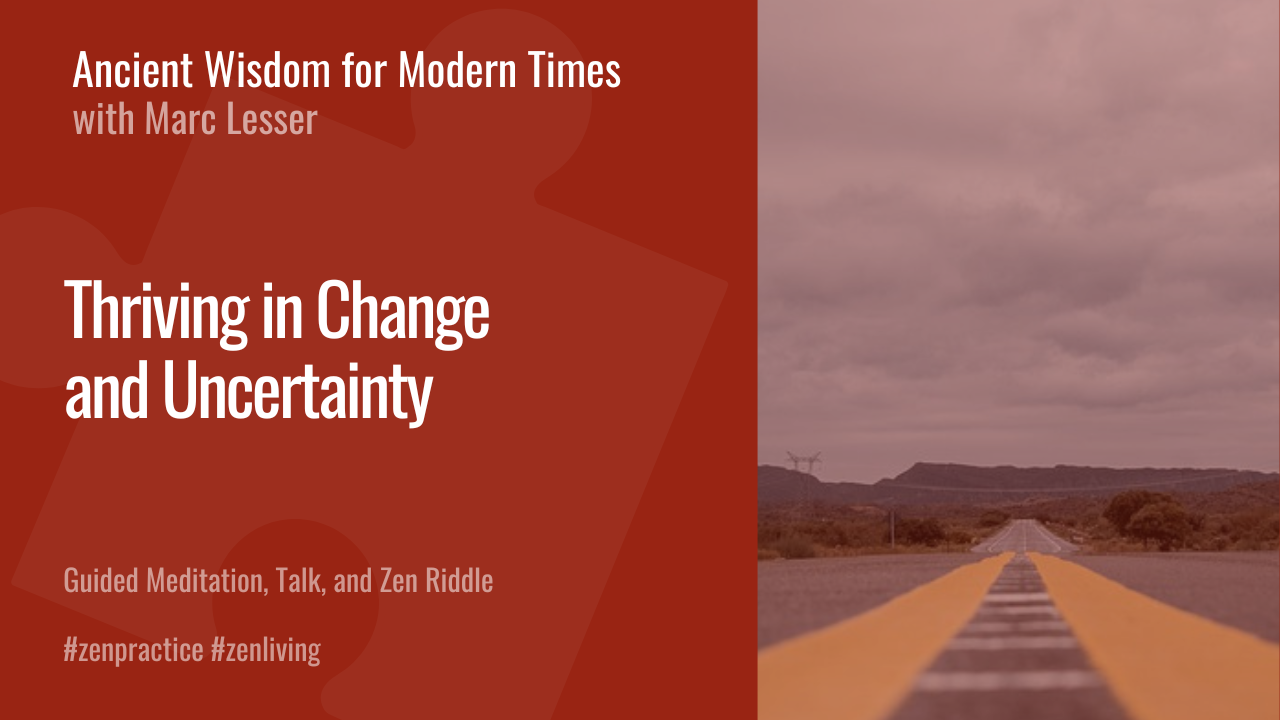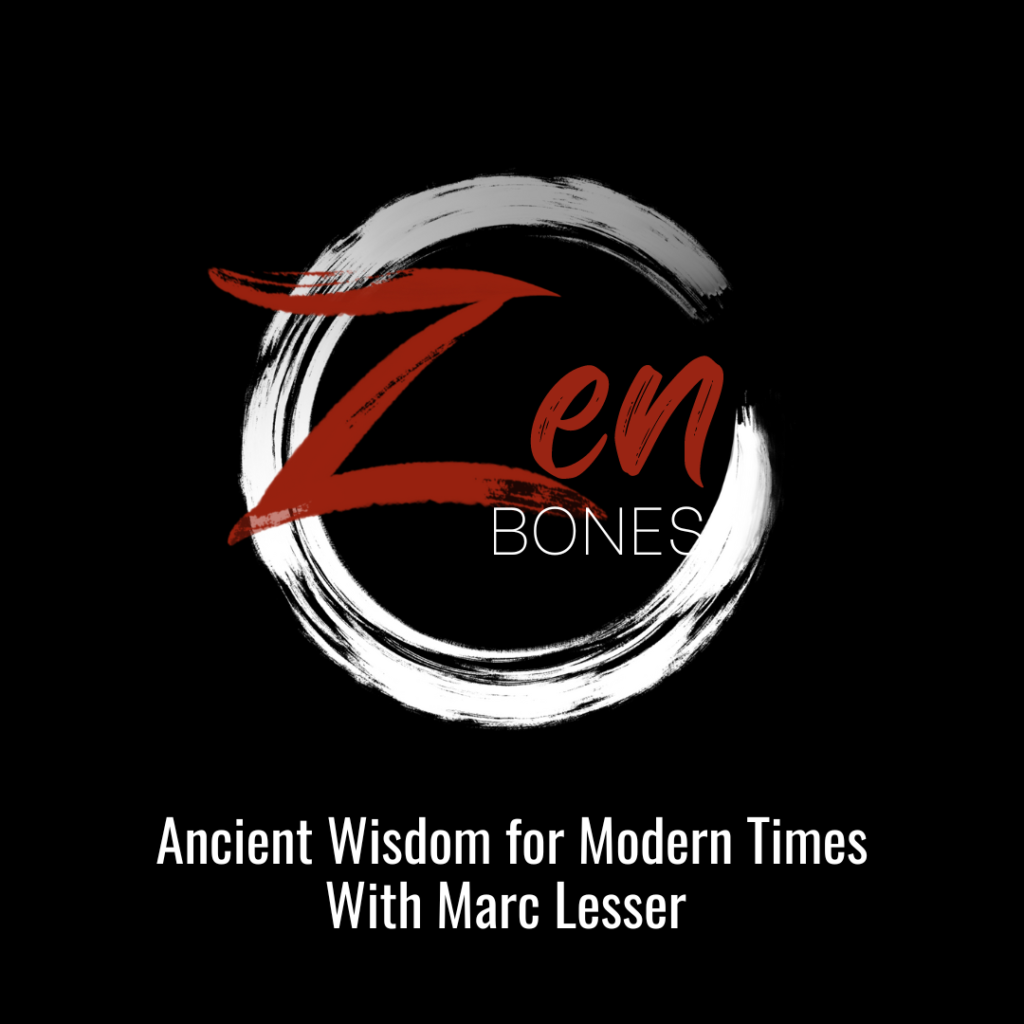Today’s episode is called Thriving in Change and Uncertainty. It begins with a short guided meditation, and then a talk about three practices for navigating and shifting our relationship with change and uncertainty. Then, today’s Zen puzzler comes from the words of Dongshan, a 9th century Chinese Zen teacher, that includes the phrase, everyone wants to leave the endless changes. It address the practice of becoming more comfortable with change and uncertainty.
EPISODE TRANSCRIPT
Marc Lesser: Welcome to Zen Bones, ancient wisdom for modern times. This is Marc Lesser. Why Zen Bones? Our world is in crisis and ever-shifting, and now more than ever, more wisdom, clarity, and courage are essential, especially in the world of work, business, and leadership.
Marc Lesser: Today’s episode is called Thriving in Change and Uncertainty. We begin with a short guided meditation, and then I talk about three practices for navigating and shifting our relationship with change and uncertainty. Today’s Zen puzzler comes from the words of Dongshan a ninth-century Chinese Zen teacher that includes the phrase, “Everyone wants to leave the endless changes.” I hope you enjoy today’s episode.
[pause 00:00:57]
Marc Lesser: Now, let’s begin with some sitting practice, some meditation practice together.
[pause 00:01:14]
[bell ringing]
Marc Lesser: Dropping in, arriving, pausing. In this ordinary, ordinary practice of bringing awareness to the body, to the breath, feelings, thoughts ordinary and not so ordinary.
[pause 00:02:08]
Marc Lesser: Bringing an approach, attitude of curiosity. Think of it as a warmhearted curiosity. What is it like to be here now? What is it like to be breathing using the breath as a anchor, some stability. Letting thinking mind do its thing, but gently bringing awareness, bringing attention back to the breath, to the body.
[silence]
Marc Lesser: Opening our minds and hearts.
[pause 00:03:43]
Marc Lesser: What does it feel like? What is it like in the body if there were nothing lacking? Right now, there’s nothing to strive for. Zen teacher Shunryu Suzuki uses the expression no gaining idea. No gaining idea [chuckles] and yet he also says, “If we’re going to bake bread, we should make tasty bread.” We do that by watching with care, noticing how water and flower transform in this practice just watching, just without any sense of anything missing, allowing our full functioning to arise. Just putting ourselves into the oven of our awareness and attention, and keeping it simple. Breathing in, breathing out.
[pause 00:06:26]
Marc Lesser: I’m going to ring the bell. You can stay with me or please feel free to continue sitting if that’s what calls to you.
[bell ringing]
Marc Lesser: Thriving, navigating uncertainty. We certainly are living in a time of tremendous change and uncertainty. In some way, I think this heightened lack of clarity makes it difficult to see and understand our tendency to avoid or deny just how uncertain our lives really are on any given day. More clarity might be our most essential need and path as individuals in relationships and throughout our communities and our world. I think clarity is often obscured by our habit energy and how we respond to change and uncertainty.
Finding clarity and equanimity and freedom in the midst of uncertainty is core important Zen practice, human practice, I think, that can benefit everyone regardless of our age or gender or race or faith or profession. I often come back to one of my favorite Zen teachers of all time Dongshan who lived during a ninth-century China, which was the golden age of Zen. He talked about these three ways of navigating change or finding more clarity. These three ways are what he called the bird path, the mysterious way, and the open hand.
I suspect that even, and maybe especially in ninth-century China, there who was a great deal of uncertainty about day-to-day life. Let’s look at these three teachings and how they might be applied as practices as ways of living ways, things that we can learn from and integrate into our challenging and uncertain world. The first is what he called the bird path, which is leaving no trace in the midst of activity. This in a way is the opposite of a worker, or leader, or manager who has a way of leaving stress or a wake of difficult emotions.
For example, when we feel impatient, it’s a really common sense to leave a wake of impatience, and blame, and communicate dissatisfaction or even to put others down. The bird path, the aim is to notice this feeling, any feeling of impatience or a sense of urgency, and to be able to find a sense of openness, curiosity, warmhearted curiosity right in the midst of whatever we’re feeling. This is challenging. The bird path is challenging and is aspirational. Much of these practices, I think, are aspirational in nature. Like I was describing during our meditation, on the one hand, let go of any gaining idea, but of course, we want to be able to do things well. We want to even be more sage-like.
This is something as I’ve been rereading Shunryu Suzuki’s Zen Mind, Beginner’s Mind, I’m struck by this apparent paradox of no gaining idea, and at the same time, this aspiration to be awake, to be more sage-like. The bird path feels like that. This is the practice of being, I think, so comfortable in our own skin that we’re able to not be fooled, not be drawn into denying or overreacting. Finding just the right way. An appropriate response. The bird path is like soaring more effortlessly and effectively dropping into more effortlessness and effectiveness and leaving no Trace, the bird path.
The second practice that Dongshan talks about is what he calls the mysterious way. Recognizing and appreciating how much we don’t actually know. Finding comfort in this not knowing. At the heart of this practice is greater comfort and effectiveness while responding to change and uncertainty, a skill that most of us can use right now. Practicing with and embracing this mystery allows us to find our way with more ease and confidence, even when there are the usual patterns, when we lack the usual road signs that give us a sense of navigating our way. We make lots of decisions in our business lives, our personal lives without knowing the outcome.
We weave together stories that make our decisions and our lives. We try to make our lives as explainable as possible, but underneath, we know that there is tremendous sense of uncertainty. That the world seems to mysteriously function without a specific intervention. Fish swim in the sea, the sun rises and sets, businesses start and go through their ups and downs, we work collaboratively with people from many cultures around the world.
This is the practice of the mysterious way. It’s much like in my book, Seven Practices of a Mindful Leader, the practice, don’t be an expert. None of us are experts in the realm of relationships, or mindfulness, or human emotions, or consciousness. When we appreciate the mystery in these realms, we can learn to live more with a sense of openness, curiosity, and even in sense of adventure as we learn and grow. This is the second practice, the mysterious way.
The third practice he calls the open hand. This is simple and powerful. It’s the opposite of working and living with a closed fist. I’ve noticed that many people, especially leaders or people trying to accomplish things, tend to live and lead with fists closed often with a closed mind and a heart. This often comes from a sense of scarcity. It’s a way of avoiding stress and trying to deny or avoid uncertainty. This practice of the open hand involves noticing when we are making a fist, when we’re living with any sense of rigidity.
Instead to open, open our hands, open ourselves, opening our hearts and mind. This practice of the open hand means seeing our work and our life as an offering, responding generously to needs and problems. It’s about cultivating an attitude of care and service. I want to share a poem by the wonderful poet Naomi Shihab Nye that expresses some of the spirit of Dongshan’s teachings for working with that change and uncertainty. This poem is called Burning the Old Year.
Letters swallow themselves in seconds.
Notes friends tied to the doorknob,
transparent scarlet paper,
sizzle like moth wings,
marry the air.
So much of any year is flammable,
lists of vegetables, partial poems.
Orange swirling flame of days,
so little is a stone.
Where there was something and suddenly isn’t,
an absence shouts, celebrates, leaves a space.
I begin again with the smallest numbers.
Quick dance, shuffle of losses and leaves,
only the things I didn’t do
crackle after the blazing dies.
Please experiment with Dongshan’s three ways, the bird path, the mysterious way, and the open hand. Welcome to the Zen Bones Puzzler, where I will regularly be presenting a story, or a Zen koan, or a poem, something to contemplate, to think about. A story that has purpose. It’s about developing greater insight and reflection. Not so much for a solution, but as a way to support your practice. A kind of meditation in daily life. Today’s Zen puzzler comes from the same teacher who I’ve been been talking about, Dongshan. Actually, the founder of Soto Zen Buddhism in 9th century, China.
Soto Zen is one of the living traditions. It’s a tradition that I trained in the School of Shunryu Suzuki, the school of the San Francisco Zen Center, and continues to flourish. Dongshan continues to be a much-studied and revered teacher. I love these, what I’m calling Zen Puzzlers, or Zen koan, Zen stories. This one comes just from something that it’s an interpretation of something that Dongshan said in one of his talks. It goes like this, “Without saying it is or it isn’t, do you have the courage to be at peace with this? Everyone wants to leave the endless changes, but when you stop bending and fitting your life, you come and sit by the fire without saying it is or it isn’t.”
He is introducing this sense of non-duality. Can you let go of the usual sense of duality without saying it is or it isn’t? Do you have the courage to be at peace with this or at peace with it? It takes courage to not be caught by calling ourselves successes or failures, or to get caught by any of the usual dualities of what we should be doing or shouldn’t be doing. Is it this or that? This is a encouragement to not be caught by the relative world of duality and instead to open up to some greater possibility.
Then the next line, he says, “Everyone wants to leave the endless changes.” That it’s recognizing change and uncertainty and to be okay with noticing our own resistance to change and uncertainty here. This great Zen teacher, even though change and impermanence is one of the core assumptions, one of the core underlying tenets of Zen practice and also of human practice. That change is part of what– is recognizing change. Living and swimming in change and uncertainty is part of being human. He says, “Everyone wants to leave the endless changes.”
Then he goes on to say, “When you stop bending and fitting your life, you come and sit by the fire.” When we stop, I think, resisting change. When we stop living in the world of duality, we can relax. We can come and sit by the fire. This puzzler, this koan, this phrase has many possible pieces that you can work with without saying it is or it isn’t, or do you have the courage to be at peace? Everyone wants to leave the endless changes, stop bending and fitting your life and come sit by the fire. I think that’s the one I’m going to suggest and recommend that phrase when you stop bending and fitting your life, come and sit by the fire.
What does it mean when? It means noticing the ways in which we are bending and fitting and instead shift toward a radical sense of appreciating and opening and just swimming effortlessly, and when there is effort to appreciate the effort, appreciating the resistance and letting it go again and again. You might experiment without saying it is or it isn’t. Do you have the courage to be at peace with this? Everyone wants to leave the endless changes, but when you stop bending and fitting your life, come and sit by the fire. Let’s all together come and sit together by the fire. Thank you.
[music]
Marc Lesser: Listen in each week for interviews, teachings, and guided meditations. You’ll receive supportive tools for creating more meaningful work and mindfulness practices to develop yourself, to influence your organization, and help change the world. Thank you for listening.
[music]
[00:24:45] [END OF AUDIO]









